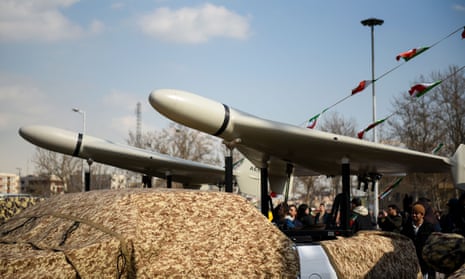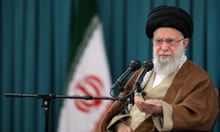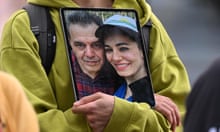Iran is emerging as a global leader in the production of cheap and lethal drones, according to US officials, who say Tehran is using the war in Ukraine as a shop window for its technologies.
Analysts at the Defense Intelligence Agency outlined how Iran had turned from being a regional drone player in the Middle East to becoming Moscow’s most significant military backer in the war.
Countering denials by Iran’s foreign ministry that its drones had been used in deadly attacks in Ukraine, including against civilian energy infrastructure, the officials shared declassified intelligence demonstrating that Iranian drones used in attacks in the Middle East – including one claimed by Iran – were identical in all significant features to drones being used in Ukraine.
One official described Tehran as having emerged as a global leader in the production of cheap and very effective drones.
Although the supply of Iranian drones to Moscow for its war in Ukraine has long been treated as fact in much reporting, as well as in multiple US briefings that have sought to describe the increasingly close military cooperation between Iran and Russia, the officials emphasised that the point of their briefing was to persuade sceptics in a global audience of the depth of the intelligence the US had amassed on Iran’s drone shipments.
Iran has supplied three models of drone to Russia: Shahed 131 and 136 single-use kamikaze drones, used by Moscow as a cheaper alternative to cruise missiles, and the Mohajer-6 multi-role drone, which can be used for intelligence gathering and to carry a missile payload.
Using in-flight footage and debris of suicide and multi-role drones used in Ukraine, the officials said they sought to disprove Iran’s denials that its drones had been used, as the US seeks wider support for sanctions against Iran over its drone supplies.
“While Iran has said it has sold drones to Russia, it has said explicitly that they have not been used in this conflict and that if they were, they would not ‘remain indifferent’,” said one official, unveiling images of debris from a Shahed 131 killer drone used in an attack in Iraq in September 2022, for which Iran took responsibility, and debris from an attack on Kyiv in October of the same year.
Save for Russian markings on the debris on the drone that struck Kyiv, the images show identical components, including the rotary engine, wooden propeller, relay board, and even the hex screws used to mount the prop.
The US analysts also compared debris from a Shahed 136 recovered from Ukraine with publicly available images of the engine of a drone displayed at the Iranian national aerospace exhibition in 2014, showing an identical ring gear, starter, exhaust and heat sink.
“What we have seen is very recognisable debris from two very different geographical regions that has come from the same source,” the officials said, describing it as “compelling evidence”.
They added that Iran appeared to be “committed to resupplying” Russia with drones.
More widely, the officials sketched out how Iran’s drone use had rapidly developed since 2014, from where its drones were being used in far more limited attacks against targets such as Saudi Aramco and shipping – including the attack on the Mercer Street tanker in 2021, which killed the vessel’s Romanian captain and a British bodyguard – to their widespread use in a major conventional war.
The analysts said they believed Tehran was quickly accumulating expertise for its drone development programme from their use in Ukraine and was probably learning valuable lessons to improve its unmanned aircraft.
Describing the reason for declassifying the intelligence on the Iranian drones, a second official explained that it was specifically aimed at countering those who remained sceptical about Iran’s supply of drones to Russia.
“The main point is that Iran’s foreign ministry is denying that they are being used. What the US and the UK want to do is provide irrefutable evidence to a global audience where there may be more scepticism,” they said.
While the US and UK have issued sanctions over Iran’s supply of drones to Russia, they are seeking wider support for these in the international community.
Underlining the mounting concerns, recent reporting from Iran suggests that Tehran believes there is a substantial market for its drones, reportedly including China.
Al-Monitor, a news website, recently reported quotes made by an Iranian military intelligence official describing the prospects of drone sales, suggesting dozens of countries were interested in them. The official is said to have made the comments at Imam Khomeini International University in the city of Qazvin.
“Our power has grown to levels where China is waiting in line to buy 15,000 of our drones,” said the official, who was introduced by the report as the director of the intelligence ministry’s thinktank for political research.
Over the weekend, the Guardian revealed how Iran has used boats and a state-owned airline to smuggle new types of advanced long-range armed drones to Russia for use in its war on Ukraine.
At least 18 drones were delivered to Vladimir Putin’s navy after Russian officers and technicians made a special visit to Tehran in November, where they were shown a full range of Iran’s technologies, sources in Iran revealed. On that occasion, the 10-man Russian delegation selected six Mohajer-6 drones.
On Monday, the UK presented evidence to the UN that Iran has been supplying advanced weapons to Houthi rebels in Yemen in breach of UN resolutions.
That came after British personnel found images of tests conducted at the headquarters of the Revolutionary Guards in Tehran on the hard drive of an unmanned aircraft seized by the Royal Navy. Personnel from the British ship HMS Montrose seized the unmanned quadcopter along with a shipment of missiles and missile parts last February.
The weapons and other evidence were presented to the UN as linking Iran to violations of security council resolutions barring weapons shipments to the Houthis, Britain’s Ministry of Defence said on Monday.










